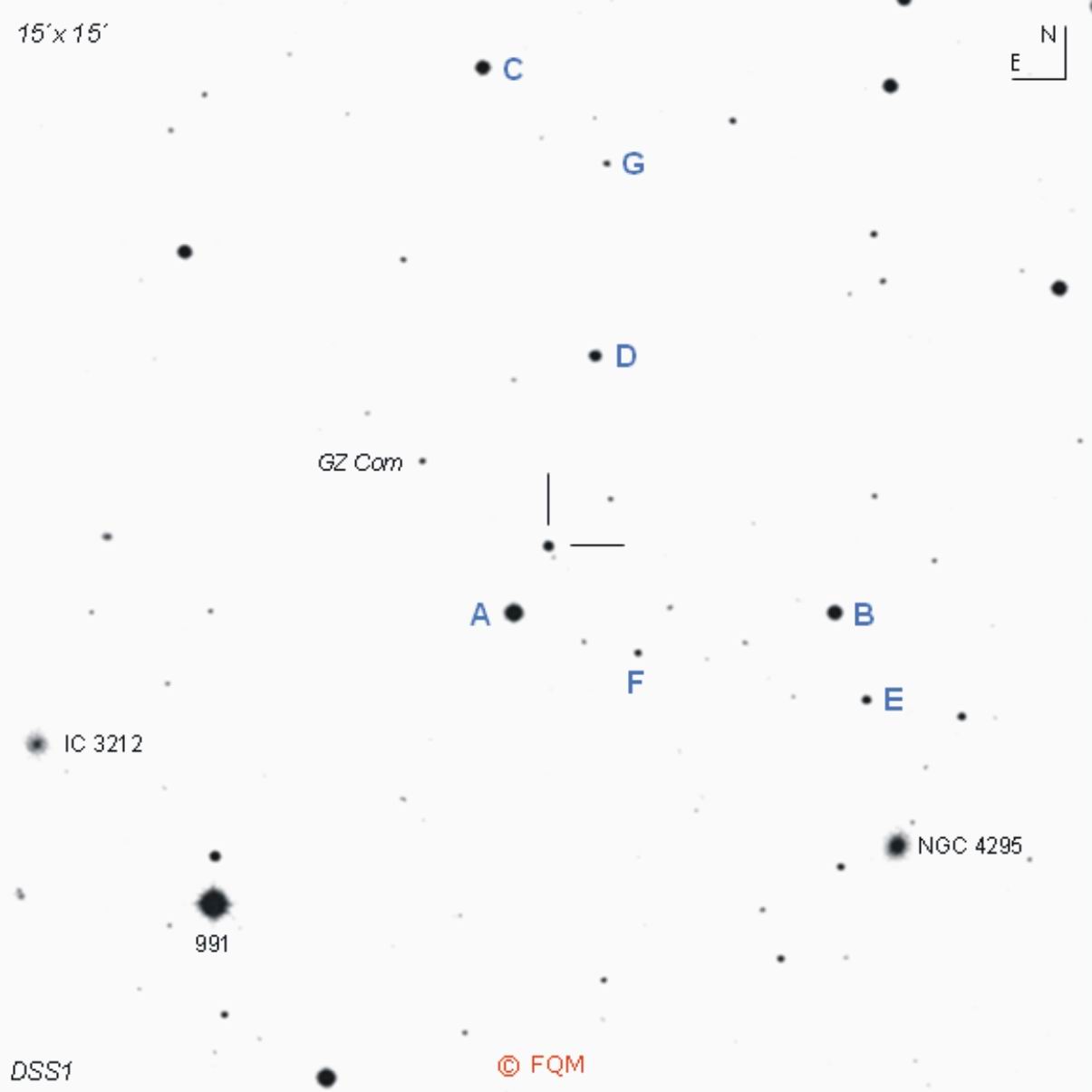
| Frankfurt Quasar Monitoring |
| W Com (ON 231) |
| Cross-Identifications |
ON
231, ON+231, 10.1916 Comae, VRO 28.12.02 SDSS J122131.69+281358.4, 1219+285, W Comae 1ES 1218+285, RX J1221.5+2813, 2EG J1222+2821 7C 1219+2830, 87GB 1219+2830, RGB J1221+282 QSO B1219+285, AAVSO 1216+28, S3 1219+28 B2 1219+28, TXS 1219+285, GeV J1222+2837 |
| Equat. coordinates | RA 12 21 31.7 DE +28 13 58 (J2000) |
| Constellation | Coma Berenices |
| Type | BL Lac |
| Redshift |
z=0.102 |
|
Distance
(2)
(3) |
414 Mpc |
| Total mag range (mv) (4) | 11.4 - 17.3 |
| Catalog Magnitude (1) | 16.11 |
| Absolute Magnitude (1) | -22.2 MB |
| Light Travel-Time (2) | 1.285 × 109 yrs |

Comparison stars
| star | B | V | Rc |
| A | 12.642 | 12.081 | 11.722 |
| B | 13.681 | 13.081 | --- |
| C | 14.471 | 13.511 | --- |
| D | 16.372 | 14.812 | 13.862 |
| E | 16.451 | 15.601 | --- |
| F | 17.712 | 16.602 | 16.032 |
| G | 17.691 | 17.051 | --- |
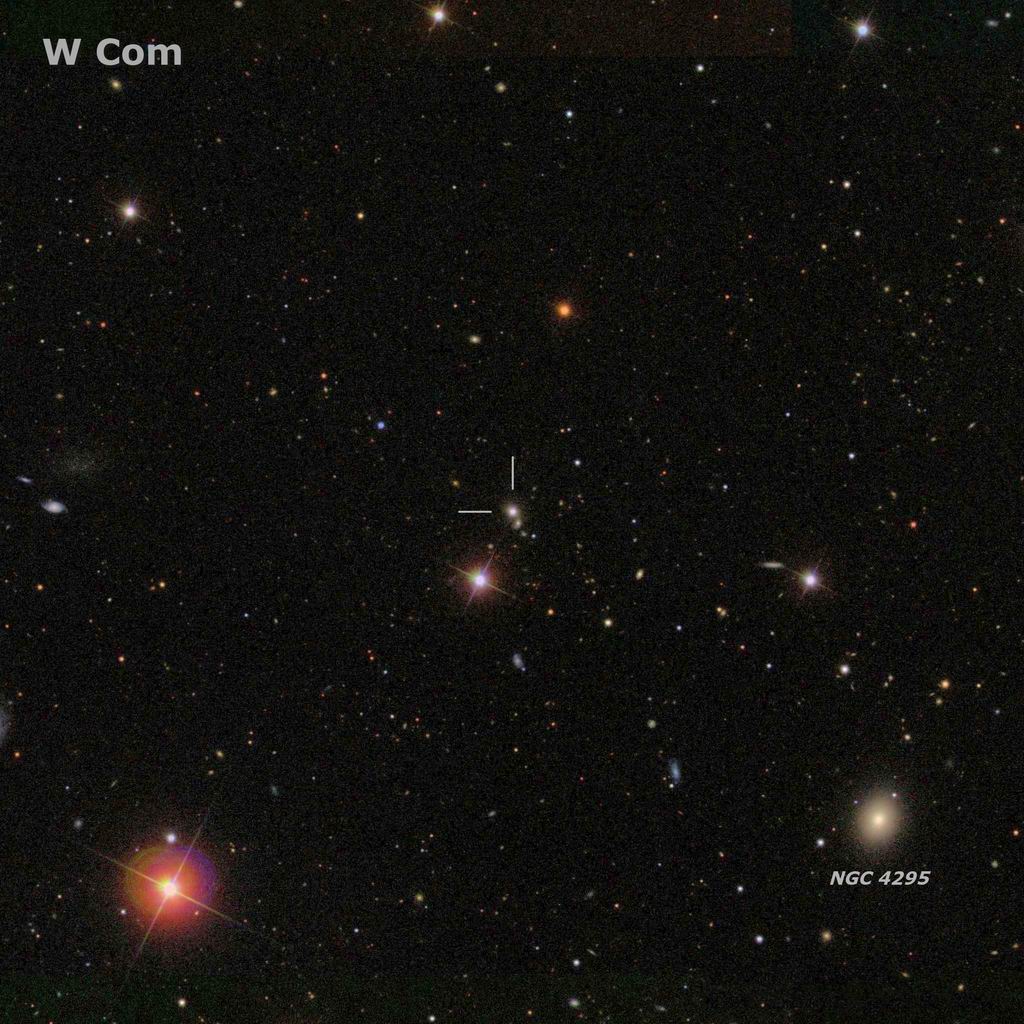
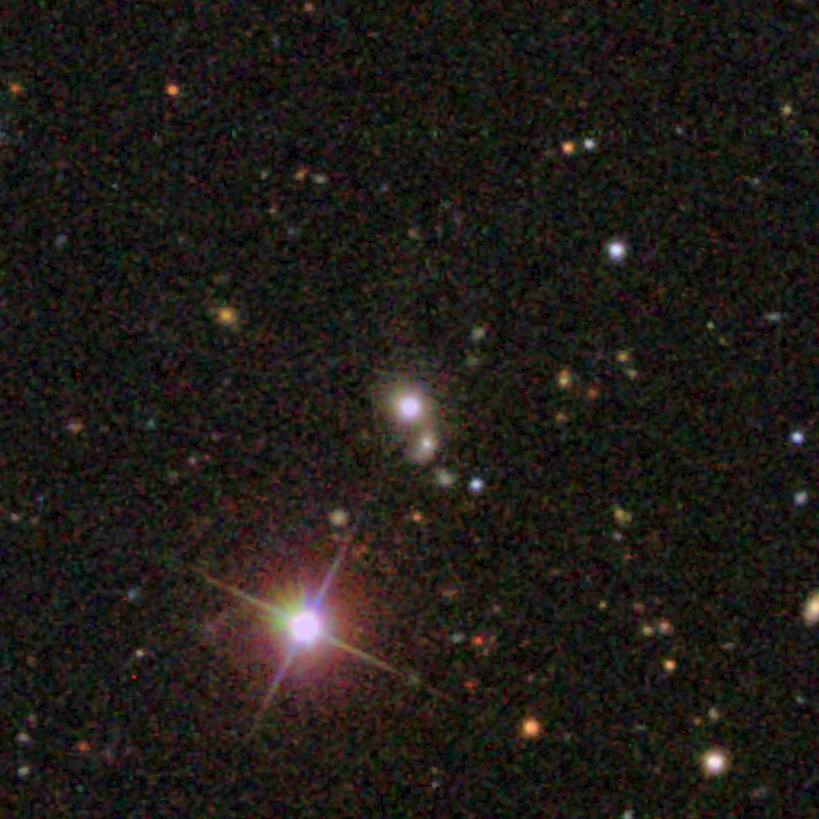 Credit:
SDSS
/
Size 3´× 3´/ N up, E left
The
host galaxy of W Com and the distorted companion galaxy
|
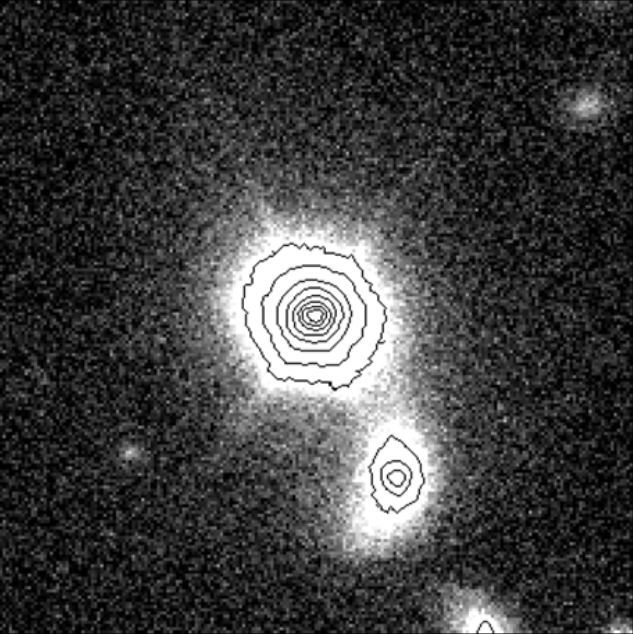 Credit:
Nilsson
et
al. (2003) / Size 35.4" × 35.4"
R-band
image by the Nordic Optical Telescope
(image
inverted) |
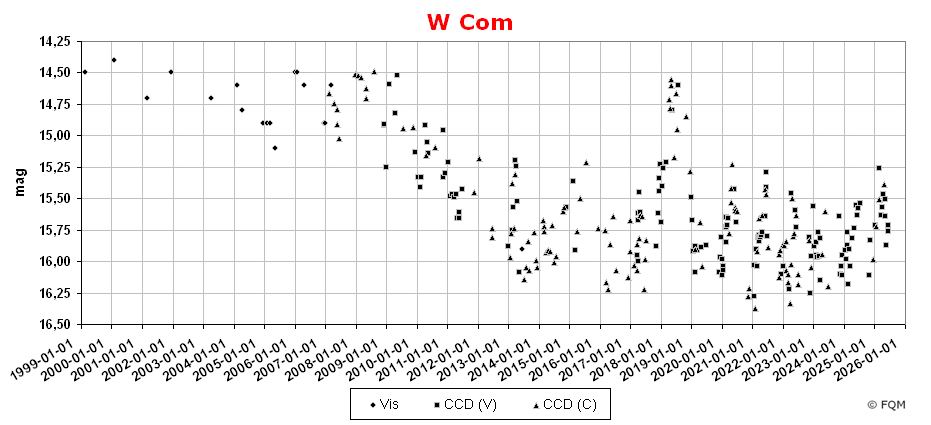
| W
Com (W Comae=ON 231=1219+285) is a violently variable BL Lac object in
Coma Berenices, located in
the north-western area of Coma Cluster Mel 111. W Com is also often
termed ON 231. W
Com was discovered by Max Wolf at Heidelberg, Germany. While
analyzing photographs, taken during the years 1892-1903 with the
Bruce-Astrograph, he found an optical variability ranging between mag
11.5
und mag 14.
Wolf classified this new object as an
ordinary variable with the
preliminary designation 10.1916 Comae. He published his discovery in
the Astronomische Nachrichten Nr. 202 in
1916. Only until 1969, this object was cataloged as the irregular
variable W
Comae in the GCVS. In
the 1960s, W Com was recognized as a radio source by the Ohio Radio
Survey (ON).
Browne and Biraud independently identified this radio source with a
stellar object (W Com) in 1971, and realized its extragalactic nature.
Just one year later, W Com was classified as a BL Lac object by
spectral
analysis. An accurate redshift was determined in 1982. The strong AGN activity of W Com is obviously triggered by the gravitational interaction between the Blazar host and a small companion galaxy (SDSS J122131.37+281349.2, 18.85g), only some 8 arcsec to the SW. The companion appears elongated and distorted due to tidal forces (see the high resolution images above). Both visual and CCD observers will detect W Com as a stellar object on an average brightness level ranging between 14 mag and 16 mag. W Com is an interesting target for visual observers with telescopes of 8- to 10-inch of aperture and larger during active state. It is very easy to locate, as the two 6-mag stars, 9 Com and 10 Com, show the way. From the two stars, just turn your telescope about 30 arcmin to the west - and there you are. CCD observers, as well as visual observers, shall use the comparison stars given above. Other photometric sequences were published by Véron et al. (1975) and Doroshenko et al. (2005). Try to avoid using comparison star D when observing with clear filter. Its reddish colour (see chart above) leads to "strange" photometric results. ____________
Starting
our visual trip into the surrounding area we first take a look at the
large open cluster Mel 111, also dubbed the "Coma
Cluster", only about
280 light-years
away. Mel 111 is an easy catch for the naked eye and binoculars,
located in the close
neighbourhood to W Com.
W Com is surrounded by a large number of bright galaxies. Deep sky showpieces like NGC 4559, NGC 4494 and NGC 4565, dubbed "The Needle", are all close by. Right next to W Com, we find two faint galaxies, easily detectable by CCD observers: NGC 4295 (14.9m, 0.6´× 0.5´, type S0) is located only 6 arcmin to the SW (see charts above). IC 3212 is an even fainter spiral, 7 arcmin to the SE (15.7m, 0.5´× 0.5´, Sc), see finding chart above. GZ Com, only 2 arcmin NE (see finding chart above), is a faint RR Lyrae-type variable, ranging between B=16.5 and B=17.5. Another violently variable quasar, 4C 29.45, is located only 5° W of W Com - at a whopping distance of more than 6×109 light-years. |
| Biraud, F. 1971, Nature,
232, 178; Rapid Optical Variability of the Source PKS 1514-24. Browne, I.W.A. 1971, Nature, 231, 515; Two Bright New Quasi-stellar Radio Sources. Craine, R.E.; A Handbook of Quasistellar and BL Lacertae Objects; Parchart Publishing House, Tuscon 1977. Cruz-Gonzales, I., Huchra, J.P. 1984, AJ, 89, 441; Continuum distributions of a x-ray observed sample of BL Lac Objects. Doroshenko, V.T., Sergeev, S.G., et al. 2005, Ap, 48, 304D; BVRI CCD-Photometry of Comparison Stars in the Neighborhoods of Galaxies with Active Nuclei. II Fiorucci, M., Tosti, G. 1996, A&AS, 116, 403; VRI photometry of stars in the fields of 12 BL Lacertae objects. Karge, S.; Helle Quasare für 8- bis 10-Zoll Teleskope. Ein Beobachtungsführer zur visuellen Beobachtung von Quasaren und BL Lacertae Objekten; Frankfurt 2005. Katajainen, S., Takalo, L.O., et al. 2000, A&AS, 143, 357; Tuorla quasar monitoring. I. Observations of 1995-1997. Liu, F.K., Xie, G.Z., Bai, J.M. 1995, A&A, 295, 1; An historical light curve of ON 231 and its periodic analysis. Lorenzetti, D., Massaro, E., et al. 1990, A&A, 235, 35; Near-infrared spectral variability in three bright BL Lacertae objects. Massaro, E., Maesano, M., et al. 1999, A&A, 342, 49; The extraordinary optical outburst of ON 231 (W Com) in spring 1998. Nilsson, K., Pursimo, T., et al. 2003, A&A, 400, 95; R-band imaging of the host galaxies of RGB BL Lacertae objects. Owen, F.N., Porcas, R.W., et al. 1978, AJ, 83, 685; Observations of radio sources with flat spectra. Pollock, J.T., Pica, A.J., Smith, A.G., et al. 1979, AJ, 84, 11; Long-term optical variations of 20 violently variable extragalactic radio sources. Steinicke, W. 1998, Interstellarum 14, 24; Im Quasar-Fieber. Steinicke, W.; Katalog heller Quasare und BL Lacertae Objekte; Umkirch 1998. Steinicke, W.; Beobachtungsliste für helle Quasare; Umkirch 1999. Steinicke, W.; Extragalactic Objects Discovered as Variable Stars; Umkirch 2000. Strittmatter, P.A, Serkowski, A., et al. 1972, ApJ, 175, L7; Compact Extragalactic Nonthermal Sources. Tosti, G., Fiorucci, M., et al. 1998, A&AS, 130, 109; BVRI-Monitoring of ON 231 during the great outburst in 1994-1997. Véron, P., Véron, M.P. 1975, A&A, 39, 281; Photographic Photometry of Five BL Lacertae-type Objects. Véron-Cetty, M.-P., Véron, P. 2001, A&A 374, 92; A Catalogue of Quasars and Active Nuclei: 10th edition. Véron-Cetty, M.-P., Véron, P. 2003, A&A 412, 399; A Catalogue of Quasars and Active Nuclei: 11th edition. Véron-Cetty, M.-P., Véron, P. 2006, A&A 455, 776; A Catalogue of Quasars and Active Nuclei: 12th edition. Véron-Cetty, M.-P., Véron, P. 2010, A&A 518, 10; A Catalogue of Quasars and Active Nuclei: 13th edition. Webb, J.R., Smith, A.G., et al. 1988, AJ, 95, 374; Optical Observations of 22 violently variable extragalactic sources: 1968-1986. Weistrop, D., Shaffer, D.B., et al. 1985, ApJ, 292, 614; Optical and radio observations for the BL Lacertae objects 1219+28, 0851+202, and 1400+162. Wenzel, K. 1999, Interstellarum 15, 36; Veränderlich und Extragalaktisch. Wenzel, K. 2005, Interstellarum 38, 54; BL Lacertae-Objekte. Eine visuelle Langzeit-Überwachung. Wenzel, K., Düskau, W. 2003, SuW 2/03, 60; BL-Lacertae-Objekte - Eine Herausforderung für den Amateur. Wing, R.F. 1973, AJ, 78, 684; UBV sequences in the fields of radio sources. Wolf, M. 1916, AN, 202, 415; Veränderlicher 10.1916 Comae und S Comae. Xie, G.Z., Li, K.H., et al. 1990, A&A, 229, 329; Search for short variability time-scales of BL Lacertae objects. Xie, G.Z., Li, K.H., et al. 1992, ApJS, 80, 683; CCD Photometry of 14 BL Lacertae objects and theoretical model. |
| Links: Landessternwarte Heidelberg Hamburg Quasar Monitoring Chara/PEGA Gary Poyner (light curve) Sloan Digital Sky Survey AAVSO |
| home |